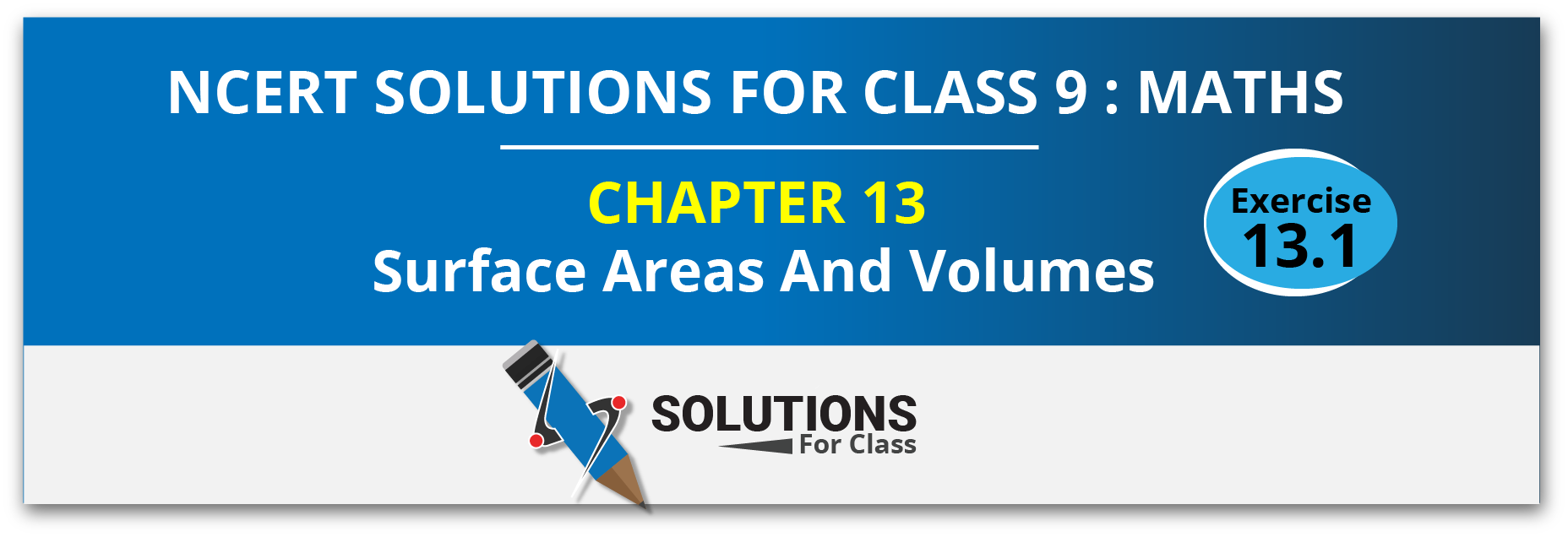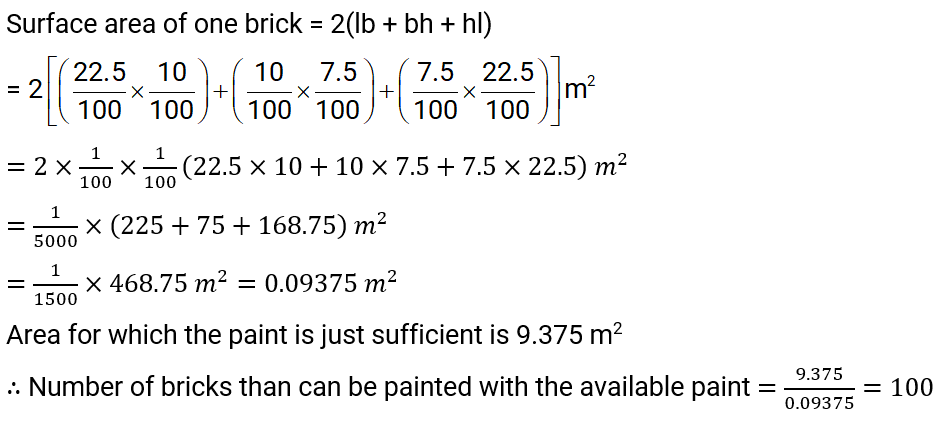NCERT Solution For Class 9, Maths, Chapter 13, Surface Areas And Volumes, Exercise 13.1 is basically related to the surface areas and volumes of cuboidal shapes, box, rectangular shapes etc. Class 9 maths Chapter 13 , Ex. 13.1 has total nine questions to study. All questions of Chapter 13, Ex. 13.1 are well explained which are given below.
Table of Contents
Toggle
Class 9, Maths, Chapter 13, Exercise 13.1 Solutions (Page no. 213)
Q.1. A plastic box 1.5 m long, 1.25 m wide and 65 cm deep is to be made. It is opened at the top. Ignoring the thickness of the plastic sheet, determine:
(i) The area of the sheet required for making the box.
(ii) The cost of sheet for it, if a sheet measuring 1m2 costs ₹20.
Ans: We have, Length, l = 1.5 m, Breadth, b = 1.25 m and Depth = Height
h = 65 cm =0.65 m
(i) Since the plastic box is open at the top. Therefore, Plastic sheet required for making such a box
= [2(l+ b) × h + lb] m2
= [2(1.5 + 1.25) × 0.65 + 1.5 x 1.25] m2
= [2 × 2.75 × 0.65 + 1.875] m2
= (3.575 + 1.875) m2 = 5.45 m2
(ii) Cost of 1 m2 of sheet = ₹ 20
∴ Total cost of 5.45 m2 of sheet = ₹ (5.45×20)= ₹ 109
Q.2. The length, breadth and height of a room are 5 m, 4 m and 3 m respectively. Find the
cost of white washing the walls of the room and the ceiling at the rate of ₹ 7.50 per m2.
Ans: Here, l = 5m, b= 4 m, and h = 3 m
Area of four walls including ceiling
= [2(l+ b) × h + lb ] m2
= [2(5+ 4) × 3+5×4 ] m2
= (2×9×3+20) m2
= (54+20) m2=74 m2
Cost of white washing is Rs 7.50 per square meter.
∴ Cost of white washing = (74×7.50)= ₹ 555
Q.3. The floor of a rectangular hall has a perimeter 250 m. If the cost of painting the four walls at the rate of ₹ 10 per m2 is ₹15000, find the height of the hall. [Hint : Area of the four walls = Lateral surface area.]
Ans: Cost of painting the four walls = Rs 15000
Rate of painting is Rs 10 per m2
Area of four walls $=\left( \frac{15000}{10} \right){{m}^{2}}=1500\,{{m}^{2}}$
⇒ 2(l + b) h = 1500
⇒ Perimeter × Height =1500
⇒ 250 × h = 1500
$h=\frac{1500}{250}=6$
Hence, the height of the hall = 6 meters.
Q.4. The paint in a certain container is sufficient to paint an area equal to 9.375 m2. How many bricks of dimensions 22.5 cm × 10 cm × 7.5 cm can be painted out of this container?
Ans:

Q.5. A cubical box has each edge 10 cm and another cuboidal box is 12.5 cm long, 10 cm wide and 8 cm high.
(i) Which box has the greater lateral surface area and by how much?
(ii) Which box has the smaller total surface area and by how much?
Ans: (i) Lateral surface area of cubical box of edge 10 cm = 4 x 102 cm2 = 400 cm2
Lateral surface area of cuboidal box
= 2(l + b) × h
= 2 × (12.5 + 10) 8 cm2
= 2 × 22.5 × 8 cm2
= 360 cm2
Thus, lateral surface area of the cubical box is greater and is more by (400 – 360) cm2 i.e., 40 cm2
(ii) Total surface area of cubical box of edge 10 cm
= 6 102 cm2 = 600 cm2
Total surface area of cuboidal box
= 2(lb + bh + hl)
= 2(12.5 × 10) + (10× 8) + (8 × 12.5) cm2
= 2(125 + 80 + 100) cm2
= (2 ×305) cm2 = 610 cm2
Thus, total surface area of cuboidal box is greater by 10 cm2.
Q.6. A small indoor greenhouse (herbarium) is made entirely of glass panes (including base) held together with tape. It is 30 cm long, 25 cm wide and 25 cm high.
(i) What is the area of the glass?
(ii) How much of tape is needed for all the 12 edges?
Ans: Here, l = 30 cm, b = 25 cm and h = 25 cm.
(i) Area of the glass = Total surface area
= 2(lb + bh + hl)
= 2(30 × 25) + (25 × 25) + (25 × 30) cm2
= 2(750 + 625 +750) cm2
= (2 × 2125) cm2 = 4250 cm2
(ii) Tap needed for all the 12 edges
= The sum of all the edges
= 4 (l + b + h) = 4(30 + 25 + 25) cm
= 4 80 cm = 320 cm
Q.7. Shanti Sweets Stall was placing an order for making cardboard boxes for packing their sweets. Two sizes of boxes were required. The bigger of dimensions 25 cm×20 cm × 5 cm and the smaller of dimensions 15 cm × 12 cm × 5 cm. For all the overlaps, 5% of the total surface area is required extra. If the cost of the cardboard is ₹ 4 for 1000 cm2, find the cost of cardboard required for supplying 250 boxes of each kind.
Ans: In case of bigger box :
l = 25 cm, b = 20 cm and h = 5 cm
Total surface area = 2(lb + bh + hl)
= 2(25 20 + 20 5 + 5 25) cm2
= 2(500 + 100 + 125) cm2
= (2 x 725) cm2
= 1450 cm2
In case of smaller box:
l = 15 cm, b = 12 cm and h= 5 cm
Total surface area = 2(lb + bh + hl)
= 2(15 12 + 12 5 + 5 15) cm2
= 2(180+ 60 + 75) cm2
= (2 x 315) cm2
= 630 cm2
Total surface area of 250 boxes of each type
= 250 (1450 + 630) cm3
= (250 2080) cm2 = 520000 cm2
Cardboard required (i.e., including 5% extra for overlaps etc.)
= $\left( 520000\times \frac{103}{100} \right)c{{m}^{2}}$ = 546000 cm2
∵ Cost of 1000 cm2 of cardboard = Rs 4
Total cost of cardboard = ₹ $ \left( \frac{546000}{1000}\times \,4 \right)$= ₹ 2184
Q.8. Parveen wanted to make a temporary shelter for her car, by making a box-like structure with tarpaulin that covers all the four sides and the top of the car (with the front face as a flap which can be rolled up). Assuming that the stitching margins are very small, and therefore negligible, how much tarpaulin would be required to make the shelter of height 2.5 m, with base dimensions 4 m × 3 m?
Ans: Dimensions of the box-like structure are l = 4 m, b = 3 m and h = 2.5 m.
Since there is no tarpaulin for the floor.
Tarpaulin required = [2(l + b ) h + lb] m2
= [2(4 + 3) x 2.5 + 4 3] m2
= (2 7 2.5 + 12) m2
= (35 + 12) m2 = 47 m2
NCERT Solutions For Class 9, Maths, Chapter 13, Surface Areas And Volumes (All Exercises)
- Class 9, Maths, Surface Areas And Volumes, Exercise 13.1
- Class 9, Maths, Surface Areas And Volumes, Exercise 13.2
- Class 9, Maths, Surface Areas And Volumes, Exercise 13.3
- Class 9, Maths, Surface Areas And Volumes, Exercise 13.4
- Class 9, Maths, Surface Areas And Volumes, Exercise 13.5
- Class 9, Maths, Surface Areas And Volumes, Exercise 13.6
- Class 9, Maths, Surface Areas And Volumes, Exercise 13.7
- Class 9, Maths, Surface Areas And Volumes, Exercise 13.8
- Class 9, Maths, Surface Areas And Volumes, Exercise 13.9

